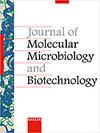Ethylbenzene Dehydrogenase and Related Molybdenum Enzymes Involved in Oxygen-Independent Alkyl Chain Hydroxylation
IF 1.2
Q2 Biochemistry, Genetics and Molecular Biology
引用次数: 41
Abstract
Ethylbenzene dehydrogenase initiates the anaerobic bacterial degradation of ethylbenzene and propylbenzene. Although the enzyme is currently only known from a few closely related denitrifying bacterial strains affiliated to the Rhodocyclaceae, it clearly marks a universally occurring mechanism used for attacking recalcitrant substrates in the absence of oxygen. Ethylbenzene dehydrogenase belongs to subfamily 2 of the DMSO reductase-type molybdenum enzymes together with paralogous enzymes involved in the oxygen-independent hydroxylation of p-cymene, the isoprenoid side chains of sterols and even possibly n-alkanes; the subfamily also extends to dimethylsulfide dehydrogenases, selenite, chlorate and perchlorate reductases and, most significantly, dissimilatory nitrate reductases. The biochemical, spectroscopic and structural properties of the oxygen-independent hydroxylases among these enzymes are summarized and compared. All of them consist of three subunits, contain a molybdenum-bis-molybdopterin guanine dinucleotide cofactor, five Fe-S clusters and a heme b cofactor of unusual ligation, and are localized in the periplasmic space as soluble enzymes. In the case of ethylbenzene dehydrogenase, it has been determined that the heme b cofactor has a rather high redox potential, which may also be inferred for the paralogous hydroxylases. The known structure of ethylbenzene dehydrogenase allowed the calculation of detailed models of the reaction mechanism based on the density function theory as well as QM-MM (quantum mechanics - molecular mechanics) methods, which yield predictions of mechanistic properties such as kinetic isotope effects that appeared consistent with experimental data.乙苯脱氢酶及参与不依赖氧的烷基链羟基化的相关钼酶
乙苯脱氢酶启动厌氧细菌降解乙苯和丙苯。虽然这种酶目前只在红环科的一些密切相关的反硝化细菌菌株中发现,但它清楚地标志着一种普遍存在的机制,用于在缺氧的情况下攻击顽固的底物。乙苯脱氢酶属于DMSO还原酶型钼酶的亚家族2,与参与对花香烃、固醇类异戊二烯侧链甚至可能是正构烷烃的不依赖氧羟基化的旁系酶一起;亚家族也延伸到二甲基硫化物脱氢酶,亚硒酸盐,氯酸盐和高氯酸盐还原酶,最重要的是,异化硝酸还原酶。对这些酶中的氧不依赖型羟化酶的生化、光谱和结构特性进行了总结和比较。它们都由3个亚基组成,含有一个双钼鸟嘌呤二核苷酸辅助因子、5个Fe-S簇和一个异常结连的血红素b辅助因子,并作为可溶性酶定位于质周空间。在乙苯脱氢酶的情况下,已经确定血红素b辅助因子具有相当高的氧化还原电位,这也可以推断为旁系羟化酶。已知的乙苯脱氢酶的结构使得基于密度函数理论和QM-MM(量子力学-分子力学)方法计算反应机理的详细模型成为可能,从而得出动力学同位素效应等力学性质的预测,这些预测与实验数据一致。
本文章由计算机程序翻译,如有差异,请以英文原文为准。
求助全文
约1分钟内获得全文
求助全文
来源期刊

Journal of Molecular Microbiology and Biotechnology
生物-生物工程与应用微生物
CiteScore
3.90
自引率
0.00%
发文量
0
审稿时长
>12 weeks
期刊介绍:
We are entering a new and exciting era of microbiological study and application. Recent advances in the now established disciplines of genomics, proteomics and bioinformatics, together with extensive cooperation between academic and industrial concerns have brought about an integration of basic and applied microbiology as never before.
 求助内容:
求助内容: 应助结果提醒方式:
应助结果提醒方式:


